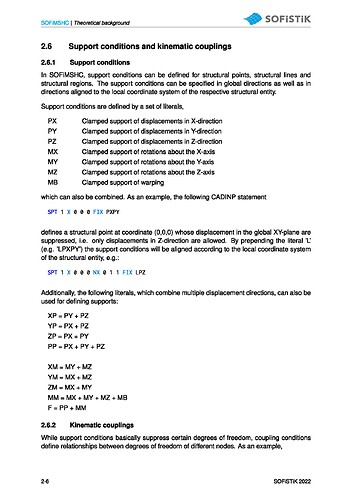Hi All,
(ENGLISH)
This is mostly a Teddy / Results question; however, I am also using Rhino and Grasshopper for Sofistik if that is important. I am currently trying to export the support points / lines and their constraint conditions into an excel file, but I have not been able to find the information for the support points in the results file that Sofistik automatically generates. I can find the node numbers of the fixed points, but I cannot find which fixation conditions (i.e. F, LPP, LPPMX, etc.) these points have, which is important since I have multiple different support types in my model. I think there must be a way to get this information out of Sofistik somehow, so if anyone knows a way, please let me know! Ideally, I would also like to be able to write a PROG file in Teddy that would allow me to automatically export this data, which I have done before for quad, beam, node elements before.
(DEUTSCH - DEEPL)
Dies ist hauptsächlich eine Teddy / Results Frage; allerdings benutze ich auch Rhino und Grasshopper für Sofistik, falls das wichtig ist. Ich versuche gerade, die Stützpunkte / Linien und ihre Fixierungsbedingungen in eine Excel-Datei zu exportieren, aber ich kann die Informationen für die Stützpunkte nicht in der Ergebnisdatei finden, die Sofistik automatisch erzeugt. Ich kann die Knotennummern der Fixpunkte finden, aber ich kann nicht herausfinden, welche Fixierungsbedingungen (z.B. F, LPP, LPPMX, usw.) diese Punkte haben, was wichtig ist, da ich mehrere verschiedene Stützentypen in meinem Modell habe. Ich denke, es muss einen Weg geben, diese Informationen irgendwie aus Sofistik herauszubekommen, wenn also jemand einen Weg kennt, lassen Sie es mich bitte wissen! Idealerweise würde ich auch gerne in der Lage sein, eine PROG-Datei in Teddy zu schreiben, die es mir ermöglicht, diese Daten automatisch zu exportieren, was ich bereits für Quad-, Balken- und Knotenelemente getan habe.
Best,
Grant
